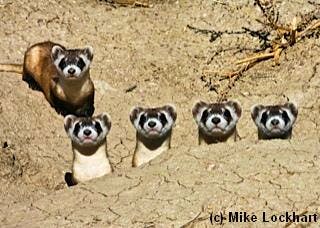Thirty years ago, the black-footed ferret was thought to be extinct, a casualty of the war this country has waged against prairie dogs for more than a century. (Black-footed ferrets are completely dependent on prairie dogs for survival: they live in prairie dog burrows and eat prairie dogs, and we’ve lost over 95 percent of prairie dogs and their colonies due to plowing of the prairie, poisoning and exotic disease.) But on September 26, 1981, a ranch dog named Shep caught a black-footed ferret in Meeteetse, Wyoming, leading to the discovery of a single remaining population. Eight of these ferrets bred successfully in captivity, and from them we now have about 1,000 ferrets in 19 reintroduction sites across the west. Successful recovery is far from guaranteed, but we are on the right track thanks to some luck and a lot of hard work.
Rocky Mountain Region Representative Jonathan Proctor attended a weekend-long “ferret festival” at Badlands National Park in South Dakota to mark the 30th anniversary of the rediscovery of the black-footed ferret. Here are some of the highlights from his trip:

The three biologists who pioneered black-footed ferret research returned to Badlands for the 30th anniversary of ferret rediscovery.
On Friday, Sept. 23, my morning started before sunrise as I traveled from my home in Missoula, Montana to Badlands National Park in South Dakota to join dozens of people who have worked over the past several decades to recover black-footed ferrets from the brink of extinction. The park’s “ferret festival” included scientific talks, media events, and – of course – tours to see ferrets in the wild. Close to 100 people attended the various events.
The festival began with the release of four captive-bred ferrets into the wild as part of the park’s ongoing effort to restore the species. The three men who helped release the ferrets were pioneers of ferret research prior to the 1979 death of the last-known captive ferret–the presumed extinction of the species. It meant a great deal to them to release these ferrets and see that their early work in ferret conservation had not been in vain.

Festival attendees were treated to a night of spotlighting for ferrets. You can see the green flicker of light in the eyes of these nocturnal predators.
When ferret researchers get together they tend to get little sleep because it’s only at night that studying ferrets in the wild takes place. As darkness fell we all went back to the park’s prairie dog towns with spotlights to search for the bright green eye shine of black-footed ferrets. This was part of the park’s annual effort to count the number of wild ferrets and evaluate the level of success at this particular site. Although the census is not yet complete for the year, the latest estimate is 25. Our day ended around 2 am, earlier than usual for a night of spotlighting for ferrets. But we all had a lot more to do in the coming days.
On Sunday afternoon, Dean Biggins discussed the latest research on sylvatic plague, the greatest threat to ferret and prairie dog survival. I’ll spare you the details, but let’s just say it’s going to be tough to save our most important ferret recovery areas from this non-native disease. For now, the only strategy we have is “dusting,” which means applying insecticide to each prairie dog burrow to kill the fleas that carry and transmit plague. This is time-consuming, expensive and probably not good for the environment. It is basically a stop-gap measure until a more efficient and affordable oral vaccine is developed to protect ferrets and prairie dogs from plague. Such a vaccine would still require regular human intervention to keep our most important prairie dog colonies alive, but quitting is not an option. If we give up, we lose not only prairie dogs and ferrets but also the many other species that thrive on large prairie dog colonies.

Juvenile prairie dogs cluster near the entrance of their burrow. Prairie dog colonies at Conata Basin have been wiped out by plague, impeding the recovery of the prairie dog-dependent, black-footed ferrets.
Next up was National Grassland biologist Randy Griebel, who updated us on the latest status of prairie dogs in Conata Basin, an area just south of Badlands National Park that is home to the largest and most important complex of prairie dog colonies on public lands in the entire Great Plains. This is an area Defenders has been working to save from both poisoning and plague for years. Conata Basin had been home to over 30,000 acres of prairie dog colonies and over 300 ferrets only a few years ago. Randy announced that Conata Basin’s prairie dog colonies are now below 10,000 acres in size, and ferret numbers are below 100. The loss is all due to plague, which first struck in 2008. The only colonies that survived were those that were dusted.
I have to admit that seeing first-hand the loss of a once-thriving prairie dog colony was tough. But all is not hopeless, and later that evening an inspirational slideshow by Michael Forsberg helped remind us of the natural beauty of the Great Plains that still exists and that we work so hard to restore. Ferrets have been given a second chance. Now it’s our job to make sure their miraculous rediscovery 30 years ago was not in vain.






Follow Defenders of Wildlife
facebook twitter instagram youtube tiktok threads